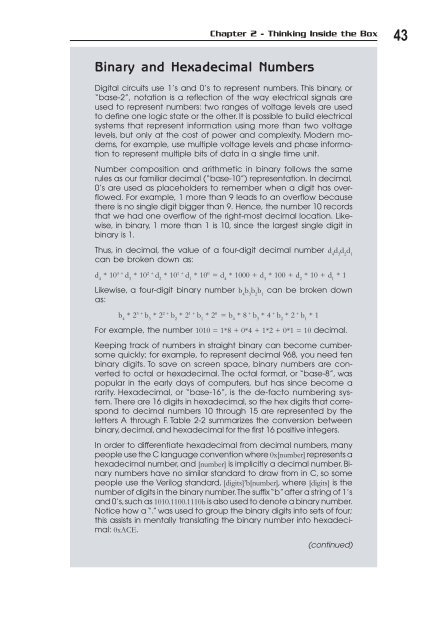Hacking the Xbox
Hacking the Xbox
Hacking the Xbox
Create successful ePaper yourself
Turn your PDF publications into a flip-book with our unique Google optimized e-Paper software.
Chapter 2 - Thinking Inside <strong>the</strong> Box 43<br />
Binary and Hexadecimal Numbers<br />
Digital circuits use 1’s and 0’s to represent numbers. This binary, or<br />
“base-2”, notation is a reflection of <strong>the</strong> way electrical signals are<br />
used to represent numbers: two ranges of voltage levels are used<br />
to define one logic state or <strong>the</strong> o<strong>the</strong>r. It is possible to build electrical<br />
systems that represent information using more than two voltage<br />
levels, but only at <strong>the</strong> cost of power and complexity. Modern modems,<br />
for example, use multiple voltage levels and phase information<br />
to represent multiple bits of data in a single time unit.<br />
Number composition and arithmetic in binary follows <strong>the</strong> same<br />
rules as our familiar decimal (“base-10”) representation. In decimal,<br />
0’s are used as placeholders to remember when a digit has overflowed.<br />
For example, 1 more than 9 leads to an overflow because<br />
<strong>the</strong>re is no single digit bigger than 9. Hence, <strong>the</strong> number 10 records<br />
that we had one overflow of <strong>the</strong> right-most decimal location. Likewise,<br />
in binary, 1 more than 1 is 10, since <strong>the</strong> largest single digit in<br />
binary is 1.<br />
Thus, in decimal, <strong>the</strong> value of a four-digit decimal number d d d d 4 3 2 1<br />
can be broken down as:<br />
d * 10 4 3 + d * 10 3 2 + d * 10 2 1 + d * 10 1 0 = d * 1000 + d * 100 + d * 10 + d * 1<br />
4 3 2 1<br />
Likewise, a four-digit binary number b b b b can be broken down<br />
4 3 2 1<br />
as:<br />
b * 2 4 3 + b * 2 3 2 + b * 2 2 1 + b * 2 1 0 = b * 8 4 + b * 4 3 + b * 2 2 + b * 1 1<br />
For example, <strong>the</strong> number 1010 = 1*8 + 0*4 + 1*2 + 0*1 = 10 decimal.<br />
Keeping track of numbers in straight binary can become cumbersome<br />
quickly; for example, to represent decimal 968, you need ten<br />
binary digits. To save on screen space, binary numbers are converted<br />
to octal or hexadecimal. The octal format, or “base-8”, was<br />
popular in <strong>the</strong> early days of computers, but has since become a<br />
rarity. Hexadecimal, or “base-16”, is <strong>the</strong> de-facto numbering system.<br />
There are 16 digits in hexadecimal, so <strong>the</strong> hex digits that correspond<br />
to decimal numbers 10 through 15 are represented by <strong>the</strong><br />
letters A through F. Table 2-2 summarizes <strong>the</strong> conversion between<br />
binary, decimal, and hexadecimal for <strong>the</strong> first 16 positive integers.<br />
In order to differentiate hexadecimal from decimal numbers, many<br />
people use <strong>the</strong> C language convention where 0x[number] represents a<br />
hexadecimal number, and [number] is implicitly a decimal number. Binary<br />
numbers have no similar standard to draw from in C, so some<br />
people use <strong>the</strong> Verilog standard, [digits]’b[number], where [digits] is <strong>the</strong><br />
number of digits in <strong>the</strong> binary number. The suffix “b” after a string of 1’s<br />
and 0’s, such as 1010.1100.1110b is also used to denote a binary number.<br />
Notice how a “.” was used to group <strong>the</strong> binary digits into sets of four;<br />
this assists in mentally translating <strong>the</strong> binary number into hexadecimal:<br />
0xACE.<br />
(continued)


